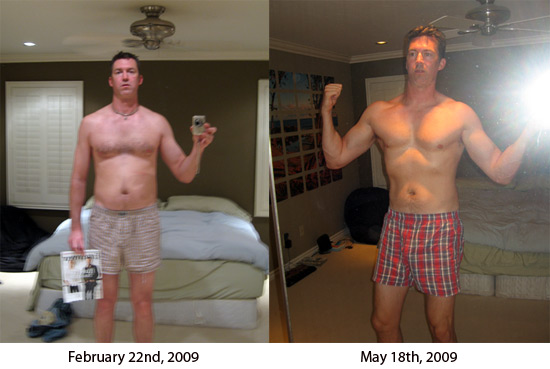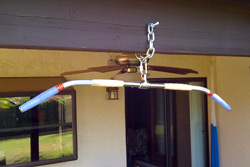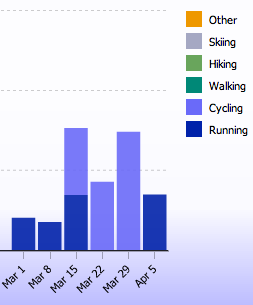Today concluded my 12-week Body For Life program. I committed to posting the before & after pics so let’s get this out of the way- here’s me in my boxers 12 weeks ago and today:

I learned a lot from this process and I’m happy with the results so far (nothing ends today – I’ll be continuing the training and the diet without a doubt). I did miss my goals of single-digit body fat and doubling the weight I can lift but I was able to move the needle from 18%BF to 14% and I can lift an average of 40% more now than when I started. Another twelve weeks and I’m confident I can attain both of those goals.
I figured I’d share some of the things I’ve learned that were non-obvious and that could be helpful to others considering the program. And let me preface everything by saying I have zero affiliation with Bill Phillips or his company. I just like his philosophy on eating and exercise and the motivational and instructional value of his book. In no particular order here’s a braindump to round out my last post of commentary from the halfway mark.
The Workbook
As I mentioned previously, the iPhone apps for tracking food and exercise are impractical as they add too much friction to the process of recording stats. Â While they are better in that they give you nifty progress graphs, you’re not optimizing for viewing, you’re optimizing for ease of capture. It’s ultimately about how much weight you put up next time and even the best app I found still required too much effort to enter stats. Print out the booklet in a combed binder at Kinko’s for $15 and use that instead. I had them do the first and last pages as cardstock because your book will weather its abuse better that way. And a combed binder works best of any binding because it makes a handy place to store a writing instrument.
You live with this book for 12-weeks. It becomes an irreplaceable, authoritative archive of how/when/what you lifted and ate. Do yourself a favor and in big permanent marker put your name, phone, email and a nice note asking people to return it if found. Â
I found the “actual vs. planned” distinction to be overkill. I think I only planned my meals and workout on the first day. Â Realistically if you belong to a big gym and go at highly trafficked times you won’t dictate which machines you can use so you end up playing it by ear. Â Same thing on meal preparation – it’s pretty unrealistic to plan out your meals for the week. You’ll end up getting a bunch of stuff at the store and deciding “at runtime” what to prepare. Lastly, I found his notation of tracking water consumption as a meal line item to be cumbersome. I just put hashmarks in the margins as a rough guess of how many glasses and at what point throughout the day I had them.
Customize the routines to your accommodate your goals
I found the program to be slanted towards fat loss as opposed to muscle gain. If I were to have followed the orthodox program I’d have only one upper body workout on alternating weeks – I found that unacceptable. Instead I altered the program to better fit my goal of muscle gain and would rotate pulling one muscle group out of the upper body day and focusing on it intensely on an adjacent cardio day. Â This seemed to work well especially since 20min for cardio leaves a lot of room for doing other exercises.Â
Google doc for streamlining grocery shopping
I’m not a big fan of grocery shopping (or any shopping for that matter). I find it tedious and almost always end up ping-ponging back and forth across the store because I forget an item in produce and then realize I needed some random cleaning product, oh and then the banannas, oh and then a toothbrush, etc. Â I did come up with a simple way to streamline things: make a google spreadsheet with all the items you could possibly need ordered by physical location right to left in the grocery store. Â Here’s . Of course I didn’t need everything on each visit but it’s way easier to skip items you don’t need rather than to forget the ones you do.Â
Value of removing decision making
Much in the same way that Getting Things Done alleviates the burden of decision making and turns your todo list into a set of executable units, the BFL program does the same for eating and working out. Â You know exactly what to do each day when it gets to a meal or workout- simply refer to the relevant page in the book and build upon what you did before. I believe this accounts for 50% of the magic of the program. The other 50% are the motivating stories from the book and Bill’s somewhat-cheesy but clearly genuine interest in helping people get over the hump and achieve their fitness improvement goals.Â
Certain exercises can be done everyday
 I found that abs and pull-ups are exercises that can be done everyday. I hung a wide-lat pull-up bar on my back patio and made a habit of doing a set when I woke up and before I went to bed. It cost a total of $50 for all the materials and took about an hour to set it up. Basically I drilled a hole through the beam and fitted it with a chain that held up the bar via a c-clamp. Doing a set of pull-ups and situps every morning and evening has become a habit.
I found that abs and pull-ups are exercises that can be done everyday. I hung a wide-lat pull-up bar on my back patio and made a habit of doing a set when I woke up and before I went to bed. It cost a total of $50 for all the materials and took about an hour to set it up. Basically I drilled a hole through the beam and fitted it with a chain that held up the bar via a c-clamp. Doing a set of pull-ups and situps every morning and evening has become a habit.
Tupperware + cut fruits & veggies = awesome
I used to pay $7 for the pre-cut bowl of cantaloupe slices- what a waste. You can pay $.80 for a fresh whole cantaloupe and spend 10min cutting it up and have more and fresher slices that you save in a tupperware container for the rest of the week. This works with fresh veggies as well. I still buy packs of frozen but typically buy a fresh vegetable and then cut it up and store a few servings in the fridge for the rest of the week.
Burn your boats
I’m a fan of publicizing goals. I believe when you make a goal privately to yourself it’s very easy to blow it off and fall short. Posting them in a conspicuous place however puts the power of peer pressure in your favor: you know that people will be reading it and will hold you to it.  A number of times I was on the fence about blowing off the gym or having a dessert and I thought about the idea of posting a before an after pic that looked identical. I posted a set of goals on my bathroom mirror when I started and I don’t mind posting them here because I know my friends that read my blog will help hold me to them. Ultimately it’s about doing whatever you need to to get motivated and stick to your commitment.Â
Well tihat’s about all the observations I have. Â To be clear I did this using no supplements other than protein shakes and power bars. The majority of the change manifests towards the last part of the 12wks but if you stick to the plan a transformative change is possible in a short time. Â I encourage anyone considering a diet / exercise program to check this one out. I’m very happy with the results and plan to continue the regimen of eating and exercise indefinitely. If you’re local in Phx and want to borrow the book, I have a very dog-eared and chewed up copy that I’m willing to lend anyone who asks.


 So having said that all iPhone fitness apps for weight training are bunk, I will say there’s a really useful one for running outdoors. I’ve been using
So having said that all iPhone fitness apps for weight training are bunk, I will say there’s a really useful one for running outdoors. I’ve been using 




